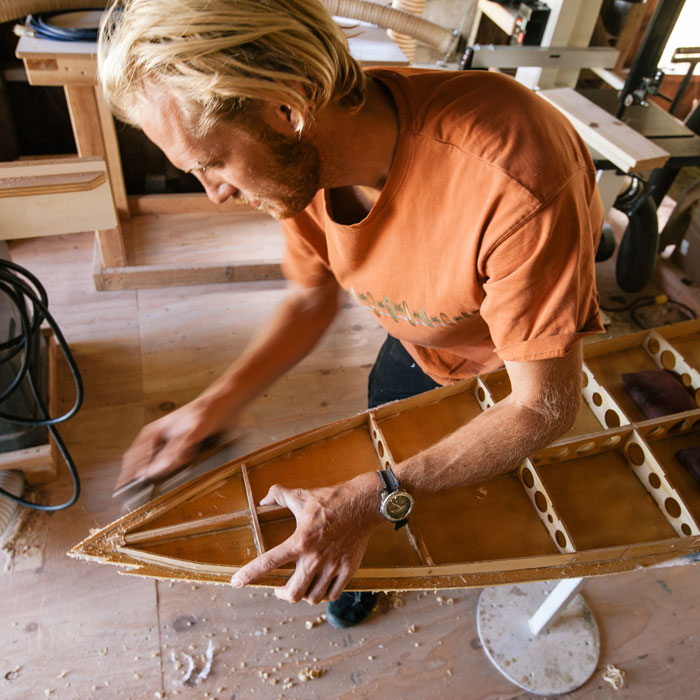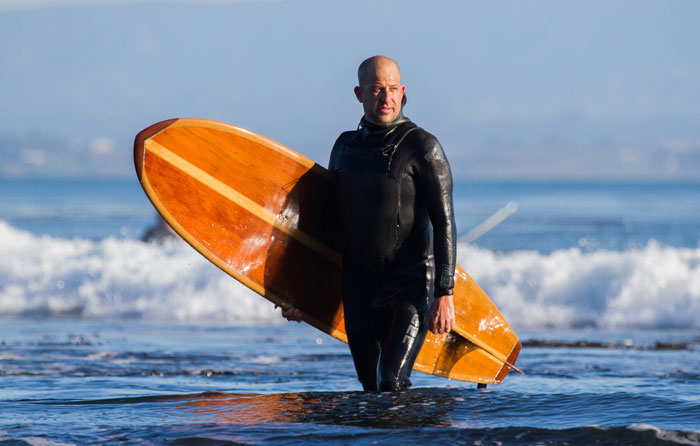Form, Function, and Sustainability
Originally published in Adventure Sports Journal.
A variegated mural hangs on Tyler Fox’s bedroom wall. Reclaimed redwood from the historic Schwann mansion hugs yellow Alaskan cedar, forming a tawny rainbow of timber. Abalone inlay shimmers across the deck; salvaged driftwood flanks the tip and tail. A professional surfer, founder of Santa Cruz Waves magazine and a longtime contestant of the Mavericks Invitational, Fox has dozens of surfboards strewn around his backyard. The 9’6″ twin fin holds this special, solitary place because it is more than a surfboard: it’s a work of art.
Ventana Surfboards and Supplies craftsman Martjin Stiphout custom shaped the board to Fox’s specifications. “He really designed and built something right up my alley,” says Fox, describing how the board trims down the line quickly, keeping its inertia in both big and small waves. Fox and Stiphout also worked together to design a special feature: a waterproof stash box built into the deck. People are “pretty flabbergasted,” when Fox unscrews the flap on his board and pulls out a Clif Bar in the lineup. “I haven’t seen too many other wooden boards that are actually functional as well,” says Fox. Ventana surfboards are hollow, meaning that they are more buoyant, easier to paddle, and faster than traditional solid wood boards.
“We don’t make surfboards just for display,” says David Dennis, co-founder of Ventana Surfboards and Supplies. “Even if they wind up on a wall, they’re all built to surf.” Though wooden surfboards are similar to foam boards in form, the shaping process is completely opposite. Rather than whittling down a piece of foam, Stiphout starts with the final shape – the frame – and essentially builds the board from the inside out. He designs the shape of the board on a computer, then cuts out the frame (which dictates the rocker and shape of the board) using a laser cutter. Next, Stiphout prepares the reclaimed wood that will form the body of the board, cleaning it and cutting it into thin slices. He glues the slices together side by side to form two sheets, which he attaches to the top and bottom of the frame, then trims them to the frame shape and adds layers of cork to the rails for impact protection. Finally, he smooths down the surface bumps, and seals the board with fiberglass and resin. The entire process takes 40-60 hours from start to finish; phased out over the course of a month.

Martijn Stiphout crafts a surfboard in the Ventana workshop (Sebastian Stiphout).
Born in South Africa, Stiphout started surfing in Holland before moving to the US in 1993. He surfed used foam boards that he repaired himself before deciding to try his hand at building a wooden one for the first time in 2010. “It was more a necessity than anything else,” he claims, though the necessity seems to stem from his compulsion to turn trash into treasure.
The first board Stiphout shaped was a thin 9’5″ with a pulled in tail. He crafted the fin, nose block and tail block out of the mahogany transom of an old Zodiac. “It was probably the worst board I’ve ever surfed, hands down,” says Stiphout. “But I really enjoyed building it, so I built a second one, and the second one turned out to be magic.” An 8’2″ with parallel rails and generous volume, the “Tanker” has been Stiphout’s favorite board ever since; it’s a stock shape that he still makes to this day. Though the 9’5″ didn’t fare so well, the legacy of the old Zodiac persists – Stiphout has continued to build boards using reclaimed wood ever since.
The name Ventana was chosen when Stiphout was driving from Mexico back to Santa Cruz. As he passed Big Sur, a Beach Boys song came on that mentioned the Ventana Wilderness, which Stiphout took as a sign. After a stint with a partner that didn’t work out, he partnered with Dennis in 2014 to form Ventana Surfboards and Supplies, a sustainable surf company focused on craftsmanship, responsibility, and adventure. Using locally sourced products, partnering with small local businesses, leaving a small footprint, and giving back to the community are a few of the values that form the foundation of the brand. “We’re not trying to earn a living doing anything that’s detrimental to anyone anywhere,” says Stiphout. “Not only is the product important to us but also where and who it’s made by.”

David Dennis with his Ventana Downrail at Pleasure Point (Dave Alexander/Salty Breeze Surf Art and Photography).
Ventana is the first surf company in the world to have its entire line of boards ECOBOARD Project Gold Verified by Sustainable Surf. “We have a rule to keep us honest in terms of sustainability, that we won’t pay for wood,” says Dennis. All of the wood used for Ventana surfboards and body surfing handplanes is reclaimed except for the frames used for the boards.
Dennis estimates that, among Ventana’s network of upcycle partners, Santa Cruz Guitar Company donates the largest volume of reclaimed material. “We have 8,000-year-old oak that was found in a swamp in the Czech Republic that we got as offcuts,” says Dennis. “Every splinter of wood has a story that we can tell.”
One of the most interesting stories is that of the Western Flyer, the boat on which John Steinbeck made a historic voyage with marine biologist Ed Ricketts in 1940, and on which their collaborative work, The Log from the Sea of Cortez, is based. Geologist John Gregg bought the boat in 2015 and is currently restoring it for use as a multimillion dollar education and research vessel. Gregg donated three floorboards from the hull and a dinner-table size section of wood from the engine room to Ventana Surfboards.

Tyler Fox on his Ventana longboard at Pleasure Point (Simon Gilbert/J2PMedia).
According to Gregg, The Log From the Sea of Cortez was Steinbeck’s favorite book. “[Ricketts] was the first guy to talk about environmental degradation of the oceans,” says Gregg. “He could see the writing on the wall.” It seems fitting that splinters from the boat which inspired Steinbeck’s writing – and his interest in ocean conservation – carry on as both functional watercraft and mindful art.
“Whenever we sell a board or a handplane with that wood, we donate some of the money back to the Western Flyer refurbishment project,” says Dennis. Indeed, Ventana donates 5% of all profits, and sometimes up to 10% of sales, to local non-profits leading the charge in ocean conservation.
“I can envision Ventana becoming the Patagonia of surfing some day,” says Dennis, who plans to grow the apparel line and expand the selection of products.

Ventana Western Flyer Fish Handplane for bodysurfing (David Dennis).
Dennis and Stiphout have a knack for product development, with two successful inventions already under their belt: the Save-A-Surf Box ($49.50) and Save-A-Surf Tool ($19.50). “The Save-A-Surf Tool was basically created because my kids had stolen my fin screws,” says Dennis. He recalls surfing Middle Peak at Steamer Lane – or rather, trying to surf – and flailing, until he discovered that two of the fins had fallen out. The third fin came off in his hand. It turned out that Dennis’s kids had taken the fin screws for another board. Dennis had to cut his session short because he didn’t have replacements. He told Stiphout about an idea for a tool with a scraper, leash cord, and fin screws; it would have enabled him to keep surfing that day.
The Save-A-Surf Box takes the idea one step further with a full-featured wax compartment edged in reclaimed mahogany wood from Santa Cruz Guitar Company. It includes a leash cord from leftover paracord used to make Khordz Mugs, a guitar pick made from spent key cards used at the Santa Cruz Dream Inn, and an eco-friendly bar of wax; as well as a bottle opener, extra fin screws, and an Allen wrench that tuns into a sundial.
Wooden instruments like the ukulele and banjolele (a cross between a banjo and a ukulele) are the latest additions to the Ventana Surfboards and Supplies product line. Stiphout and Dennis are currently working on a new top secret instrument which will launch before the end of the year, though Stiphout admits he’s not much of a musician. When he got a ukulele last year, he only played it for about half an hour. “Then I put it down and started doing research on how to build one,” Stiphout admits.
Go figure.

Ventana Adventurer Frank Scott Krueger of Humble Sea Brewing Co. bodysurfing his Ventana handplane at Its Beach (Don Moulds).

Inquiring about purchasing a handplane.